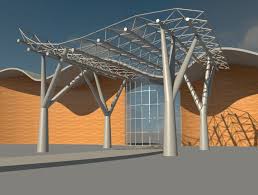Structural modelling, a critical aspect of engineering and architecture, has transformed the way we design and analyze complex structures. The rise of advanced computational techniques has allowed us to push the boundaries of creativity, ensuring stability and durability without sacrificing aesthetic beauty. In this blog post, we will delve into the sophisticated world of advanced structural modelling, explaining its core principles, methodologies, applications, and future prospects.
What is Structural Modelling?
Structural modelling refers to the mathematical representation of the physical components of a structure and their inter-relationships. This involves a comprehensive understanding of forces, deformations, materials, and geometries. Historically, these models were created using manual calculations, but with the advent of technology, advanced structural modelling has become a versatile tool that uses powerful computers to address the complex challenges in design and analysis.
The Core Principles of Advanced Structural Modelling
Finite Element Analysis (FEA)
Finite Element Analysis (FEA) is a numerical technique used to predict how a physical object behaves under various forces and conditions. It involves breaking down the structure into many smaller, simpler pieces called elements and applying the mathematical equations of physics to analyze each element’s behavior. The results are then combined to predict the overall behavior of the entire structure.
Material Modelling
Advanced structural modelling takes into consideration the complex behavior of materials under various conditions. This includes stress-strain relationships, plastic deformation, temperature effects, and more. Accurate material modelling ensures that the structure will perform as expected under real-world conditions.
Dynamic Analysis
Dynamic analysis considers the effects of time-varying loads and conditions on structures. This includes wind, earthquakes, and other forces that can change over time. By understanding these dynamic forces, engineers can design structures that withstand sudden changes and provide safety during unexpected events.
Methodologies Used in Advanced Structural Modelling
Computer-Aided Design
CAD software enables engineers to create 3D models of structures and make changes quickly and efficiently. This allows for more accurate and creative designs, and it plays a crucial role in the entire process of design and construction.
Simulation and Optimization
Simulation tools help in predicting the performance of a structure under various scenarios, while optimization techniques find the best solution by balancing performance, cost, and other factors. These methodologies make it possible to experiment with different design options virtually, saving time and resources.
Building Information Modelling (BIM)
BIM goes beyond mere geometry, embedding crucial information about materials, properties, and functions within the model itself. This collaborative approach streamlines the design, construction, and operation phases, reducing errors and improving efficiency.
Applications and Benefits
Advanced structural modelling finds application in various fields like civil engineering, aerospace, automotive, and more. It offers several advantages:
- Enhanced Design Accuracy: Accurate models lead to better-designed structures that are both functional and aesthetically pleasing.
- Cost-Effective: By simulating different scenarios, unnecessary costs can be eliminated, and optimal solutions can be found.
- Sustainability: Advanced modelling techniques can help in designing environmentally sustainable structures, considering energy efficiency and ecological impacts.
Future Prospects
The future of advanced structural modelling is promising, with emerging technologies like Artificial Intelligence and Machine Learning poised to make further breakthroughs. The integration of these technologies can lead to even more precise and efficient design processes, paving the way for structures that are unimaginable today.
Integrating Virtual Reality (VR) and Augmented Reality (AR)
In recent years, the integration of VR and AR with advanced structural modelling has been groundbreaking. These technologies allow engineers, designers, and stakeholders to immerse themselves within a virtual environment, facilitating a more profound and intuitive understanding of the structure.
Virtual Reality (VR)
VR provides a three-dimensional and interactive experience where users can walk through a virtual structure. This enables architects and engineers to visualize the space, identify potential design flaws, and make necessary adjustments before construction begins. It also enhances communication with clients, who can “experience” the design before it becomes a physical reality.
Augmented Reality (AR)
Unlike VR, which completely immerses users in a virtual world, AR overlays virtual objects on the real world. This technology can be used on construction sites to compare the actual building progress with the planned design, ensuring that everything is proceeding according to the plan.
Cross-Disciplinary Collaboration
The growing complexity of modern structures demands cross-disciplinary collaboration. Advanced structural modelling allows architects, engineers, environmental scientists, and other professionals to work together seamlessly. The shared use of comprehensive models fosters communication and understanding across disciplines, ensuring that all aspects of a project are aligned and integrated.
Challenges and Ethical Considerations
Despite its many advantages, advanced structural modelling also faces challenges:
Data Security
With the rise of connected models and collaboration platforms, ensuring the security of sensitive information becomes paramount. Unauthorized access or data breaches could lead to significant losses, both financially and in terms of intellectual property.
Ethical Considerations
Ethical considerations include responsible sourcing of materials, environmental stewardship, and social impact. Advanced structural modelling can help in these areas, but a strong ethical framework must guide the utilization of this technology to ensure that it is used for the betterment of society.
Education and Training
As advanced structural modelling continues to evolve, so does the need for education and training in this field. Universities and institutions must offer courses that equip the next generation of engineers and architects with the skills they need to harness these cutting-edge tools.
A Global Perspective
Advanced structural modelling is not limited to high-income countries or mega-corporations. Its principles and techniques are being adopted globally, including in developing regions. It has the potential to revolutionize how structures are designed and constructed everywhere, leading to more resilient and sustainable communities.
Conclusion
Advanced structural modelling represents the synthesis of mathematics, physics, and cutting-edge technology, allowing us to approach structural design with an unprecedented level of detail and insight. As our technological capabilities continue to grow, so too will our ability to create structures that are not only robust and safe but also embody the pinnacle of human creativity and innovation.
What is Advanced Structural Modelling?
Advanced Structural Modelling refers to the use of sophisticated computational tools and mathematical methods to create detailed and accurate representations of complex physical structures. This can include buildings, bridges, biological systems, or even intricate economic models.
Why is Advanced Structural Modelling Important?
It provides insights into how complex systems function and respond to different stresses and stimuli, allowing for more informed design, optimization, and failure prediction. This enhances safety, efficiency, and innovation across various domains.
What Tools Are Used in Advanced Structural Modelling?
Tools vary based on the application, including software like ANSYS, Revit, MATLAB, and others. These are complemented by advanced mathematical techniques like finite element analysis, machine learning, and more.
How is Advanced Structural Modelling Applied in Architecture?
In architecture, it’s used to simulate how buildings will behave under various conditions, such as seismic activity or wind forces. This helps architects to make design decisions that enhance both aesthetics and safety.
Can It Be Applied in Economics or Social Sciences?
Yes, structural modeling isn’t limited to physical systems. It can also be used to understand complex relationships in economics or social systems, leading to more robust policy and business strategy formation.



